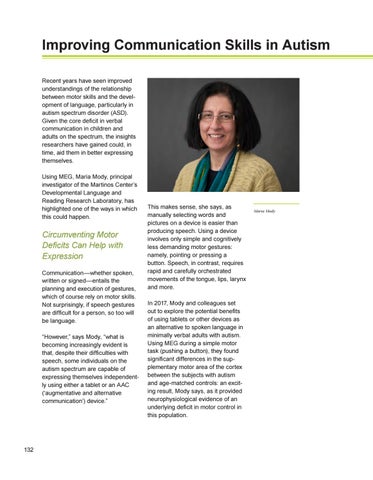Improving Communication Skills in Autism Recent years have seen improved understandings of the relationship between motor skills and the development of language, particularly in autism spectrum disorder (ASD). Given the core deficit in verbal communication in children and adults on the spectrum, the insights researchers have gained could, in time, aid them in better expressing themselves. Using MEG, Maria Mody, principal investigator of the Martinos Center’s Developmental Language and Reading Research Laboratory, has highlighted one of the ways in which this could happen.
Circumventing Motor Deficits Can Help with Expression Communication—whether spoken, written or signed—entails the planning and execution of gestures, which of course rely on motor skills. Not surprisingly, if speech gestures are difficult for a person, so too will be language. “However,” says Mody, “what is becoming increasingly evident is that, despite their difficulties with speech, some individuals on the autism spectrum are capable of expressing themselves independently using either a tablet or an AAC (‘augmentative and alternative communication’) device.”
132
This makes sense, she says, as manually selecting words and pictures on a device is easier than producing speech. Using a device involves only simple and cognitively less demanding motor gestures: namely, pointing or pressing a button. Speech, in contrast, requires rapid and carefully orchestrated movements of the tongue, lips, larynx and more. In 2017, Mody and colleagues set out to explore the potential benefits of using tablets or other devices as an alternative to spoken language in minimally verbal adults with autism. Using MEG during a simple motor task (pushing a button), they found significant differences in the supplementary motor area of the cortex between the subjects with autism and age-matched controls: an exciting result, Mody says, as it provided neurophysiological evidence of an underlying deficit in motor control in this population.
Maria Mody
